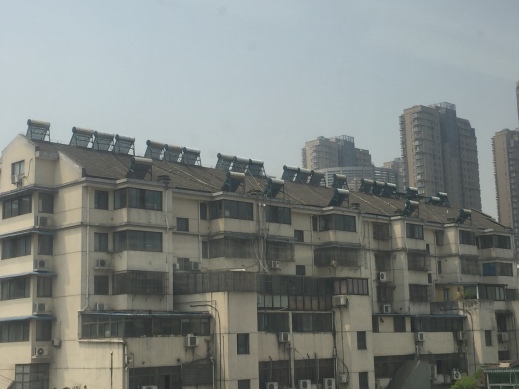Today we headed to Shanghai, and it was my turn to give a bus talk. One of the assignments we had for the Study Abroad “class” was to choose a topic of interest (in China) and write a paper, and then give a 15-minute talk on one of the numerous bus rides. Since my background is in Chemistry and Environmental Studies the topic I chose was the pollution in China and the countermeasures its citizens and government were taking. While I was in China I was surprised by a number of measures I was able to physically see. I was expecting to hear about the topic some in the business meetings but was resigned to researching further to suss out what was being done, I was, however, pleasantly surprised.
While I was in China I was surprised by a number of measures I was able to physically see. I was expecting to hear about the topic some in the business meetings but was resigned to researching further to suss out what was being done; I was, however, pleasantly surprised.
The first action that stood out was rows and rows passive solar water heaters on the roofs of homes and apartments in the cities. As cold water runs through the tubes on the roof the sun heats the water; once the water is hot and has run through all the tubing it goes to a storage tank in the home/apartment. This system is not as efficient as active solar heaters (i.e. using solar panels to generate energy to heat water), but they are cheaper to install, more reliable and often will last longer which is appealing to the mass Chinese market.

In my pre-trip research, I came across an article discussing the number of nuclear power plants in China and found it to be a relatively low number (36) considering the size of China, but while traveling I found that most of those plants are centralized around the big cities. On our one hour train ride from Suzhou to Nanjing we passed four nuclear power plants, and on our drive to Shanghai we passed at least two more (I am fairly certain that there are four plants surrounding Shanghai)

A less visible action is the limiting of cars in big cities. This doesn’t appear apparent at all as traffic in all the tier 1 cities is absolutely abysmal, unlike any other city or country I have ever visited. However, one of the professors at Soochow University explained that the cities were taking various measures to decrease the number of cars on the road. In both Beijing and Shanghai only certain license plate numbers are allowed on the main roads on certain days (e.g. even numbers can drive MWF, and the odd numbers the other days). In addition to limiting driving days, it is not easy to obtain a license plate. In Shanghai, it may cost $20,000 to purchase a license plate and in Beijing, there is a lottery system. I am sure this is influencing and lowering carbon emissions, however, as stated it is not immediately visible.
As for the bus ride itself other than standing with a microphone on a moving bus was pretty uneventful. After the few talks, most everyone took a nap until we got to the outskirts of Shanghai. More about Shanghai adventures later.